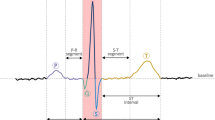Abstract
A new method for the assessment of the atrial fibrillatory wave (AFW) from the ECG is presented. This methodology is suitable for signals registered from Holter systems, where the reduced number of leads is insufficient to exploit the spatial information of the ECG. The temporal dependence of the bio-electrical activity were exploited using principal component analysis. The main features of ventricular and atrial activity were extracted, and several basis signals for each subspace were determined. Hence, the estimated (AFW) are reconstructed exclusively from the basis signals that formed the atrial subspace. Its main advantage with respect to adaptive template subtraction techniques was its robustness to variations in the QRST morphology, which thus minimised QRST residua. The proposed approach was first validated using a database of simulated recordings with known atrial activity content. The estimated AFW was compared with the original AFW, obtaining correlation indices of 0.774±0.106. The suitability of this methodology for real recordings was also proven, though its application to a set of paroxysmal AF ECGs. In all cases, it was possible to detect the main frequency peak, which was between 4.6 Hz and 6.9 Hz for the patients under study.
Similar content being viewed by others
References
Bollmann, A., Sonne, K., Esperer, H., Toepffer, I., Langberg, J., andKlein, H. (1999): ‘Non-invasive assessment of fibrilatory activity in patients with paroxysmal and persistent atrial fibrillation using the holter ECG’,Cardiovasc. Res.,44, pp. 60–66
Castells, F., Rieta, J., Millet, J., andZarzoso, V. (2005): ‘Spatiotemporal blind source separation approach to atrial activity estimation in atrial tachyarrhythmias’,IEEE Trans. Biomed. Eng.,52, pp. 258–267
Holm, M., Pehrson, S., Ingemansson, M., Sörnmo, L., Jahansson, R., Sandhall, L., Sunemark, M., Smideberg, B., Olsson, C., andOlsson, S. (1998): ‘Non-invasive assessment of the atrial cycle length during atrial fibrillation in man: introducing, validating and illustrating a new ECG method’,Cardiovasc. Res.,38, pp. 69–81
Hyvärinen, A., Karhunen, J., andOja, E. (2001): ‘Independent component analysis’ (John Wiley & Sons, New York, 2001)
Joliffe, I (2002): ‘Principal component analysis’ (Springer Verlag, Berlin, 2002)
Langley, P., Bourke, J., andMurray, A. (2000): ‘Frequency analysis of atrial filbrillation’. Proc. Int. Conf. IEEE Computers in Cardiology 2000, IEEE Computer Society Press, pp. 65–68
Langley, P., Rieta, J., Stridh, M., Millet, J., Sörnmo, L., andMurray, A. (2003): ‘Reconstruction of atrial signals derived from the 12-lead ECG using atrial signal extraction techniques’. Proc. Int. Conf. IEEE Computers in Cardiology 2003, IEEE Computer Society Press, pp. 129–132
Moody, G., andMark, R. (1989): ‘QRS morphology representation and noise estimation using the Karhunen-Loève transform’. Proc. Int. Conf. IEEE Computers in Cardiology, 1989, IEEE Computer Society Press, pp. 269–272
Pehrson, S., Holm, M., Meurling, C., Ingemansson, M., Smideberg, B., Sörnmo, L., andOlsson, S. (1998): ‘Noninvasive assessment of magnitude and dispersion of atrial cycle length during chronic atrial fibrillation in man’,Eur. Heart J.,19, pp. 1836–1844
Rieta, J., Rieta, F., Rieta, C., Rieta, S., Rieta, V., Rieta, Z., Rieta, J., Rieta, M. (2004): ‘Atrial activity extraction for atrial fibrillation analysis using blind source separation’,IEEE Trans. Biomed. Eng.,51, pp. 1176–1186
Slocum, J., Sahakian, A., andSwiryn, S. (1992): ‘Diagnosis of atrial fibrillation from surface electrocardiograms based on computer-detected atrial activity’,J. Electrocardiol.,25, pp. 1–8
Stridh, M., andSörnmo, L. (2001): ‘Spatiotemporal QRST cancellation techniques for analyses of atrial fibrillation’,IEEE Trans. Biomed. Eng.,51, pp. 105–111.
Stridh, M., Meurling, C., Olsson, B., andSörnmo, L. (2003): ‘Detection of autonomic modulation in permanent atrial fibrillation’,Med. Biol. Eng. Comput.,41, pp. 625–629
Rights and permissions
About this article
Cite this article
Castells, F., Mora, C., Rieta, J.J. et al. Estimation of atrial fibrillatory wave from single-lead atrial fibrillation electrocardiograms using principal component analysis concepts. Med. Biol. Eng. Comput. 43, 557–560 (2005). https://doi.org/10.1007/BF02351028
Received:
Accepted:
Issue Date:
DOI: https://doi.org/10.1007/BF02351028




